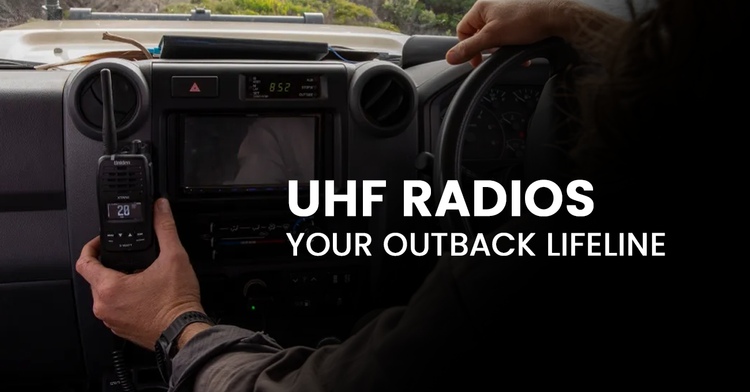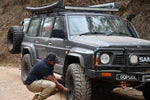UHF RADIOS: YOUR OUTBACK LIFELINE (AND WHY YOUR ANTENNA CHOICE MATTERS MORE THAN YOU THINK)

G'day, fellow red dust-eaters! If you've spent more than five minutes planning an outback expedition, you've likely been told you "need a UHF." But what separates the proper communication setups from the blister-packed toys at your local auto shop? Today, we're diving deep into the world of UHF radios and the single component that determines whether your desperate call for help reaches someone or simply dies in the ether: your antenna.
The Brutal Truth About UHF Radios
Let's start with the reality check: Your fancy 5-watt radio with 200 memory channels and voice scrambling is essentially worthless without the right antenna. I learned this lesson the hard way when my first outback expedition left me shouting into what might as well have been an expensive paperweight while my mate's "budget" setup was reaching stations 15km away.
UHF (Ultra High Frequency) radio waves are essentially line-of-sight. They don't bend around the Earth like some other frequencies. They don't magically tunnel through mountains. They behave more like light than you might expect. And that's why your antenna selection makes or breaks your communication capability.
Antenna Types: The Good, The Bad, and The Utterly Useless
The Stubby Antenna (AKA The "I Just Want To Look The Part" Special)
Range: About as far as you could throw a Tim Tam Durability: Will survive a nuclear apocalypse Practicality: Perfect for mall-crawlers who never leave the bitumen
The stubby antenna is the UHF equivalent of bringing a knife to a gunfight. These compact units sit about 15-20cm tall and have become increasingly popular because they don't snag on branches or garage doors. They're virtually indestructible because, well, there's not much to destroy.
But here's the catch: Physics doesn't care about your aesthetic preferences. These antennas typically deliver 0-2.1 dBi gain, which in practical terms means you'll be lucky to communicate beyond 1-2km in optimal conditions. If you're only using your UHF to coordinate bathroom breaks at highway rest stops, they'll do the job. For anything involving actual remote travel, they're dangerously inadequate.
The Whip Antenna (The Sensible Middle Ground)
Range: 3-5km typical, up to 8km with elevation Durability: Will flex but eventually snap after enough abuse Practicality: The Toyota Corolla of antennas—sensible, reliable, unexciting
These 45-60cm flexible antennas represent the minimum viable option for genuine off-road use. Typically offering 3-6 dBi gain, they provide reasonable performance without excessive height. They're the standard equipment on rental 4WDs for good reason—they're the compromise point between durability and functionality.
The flexibility helps them survive most branch strikes, though I've personally snapped three over the years in particularly dense High Country scrub. If you're running a single antenna setup and mixing highway and off-road driving, this is your best bet, particularly if you opt for a spring base to add additional forgiveness.
The Fiberglass Whip (For When Communication Actually Matters)
Range: 8-15km typical, much more from elevated positions Durability: Surprisingly robust until it isn't Practicality: Like bringing a proper medical kit—seems excessive until you actually need it
Now we're talking serious business. These 900mm-1.2m antennas provide 6-9 dBi gain, dramatically increasing your effective range. The physics is simple: The longer the antenna (up to a point), the better the gain and the further your signal travels.
The white fiberglass construction offers impressive durability considering their height, though they'll eventually succumb to prolonged abuse. The real secret to their longevity is a proper spring base that allows them to flex rather than snap when they inevitably connect with overhanging branches.
I've maintained reliable communication over 15km with these units when both vehicles were on ridgelines with clear line-of-sight. Even in undulating terrain, 5-8km is consistently achievable. For genuine remote area travel, this is your minimum standard.
The Elevated High-Gain Beast (For The Meticulously Prepared)
Range: "Is that someone from South Australia on the channel?" Durability: About as robust as a champagne flute in a mosh pit Practicality: Perfect for basecamp operations and emergency scenarios
These towering monsters (1.5-2.4m) deliver 9+ dBi gain and can achieve frankly ridiculous ranges when properly deployed. They're too unwieldy for permanent vehicle mounting in most off-road scenarios, but they shine as deployable emergency communication systems.
The smart approach is to carry one of these dismantled in your vehicle, with a magnetic mount or clamp system. When you need maximum range—perhaps during an emergency or when setting up a base camp—you can deploy it on your stationary vehicle's roof for dramatically improved communications.
I've personally witnessed these units achieve over 30km range when both parties were at elevation with clear line-of-sight. That's not theoretical—that's actual field-tested performance that could make the difference in a genuine emergency.
Mounting Matters: Location, Location, Location
Your antenna's mounting position dramatically affects performance, often more than people realize:
Bull Bar Mounting: The Convenient Compromise
Bull bar mounts are popular because they're convenient and keep the antenna away from the cabin. The downside? Your vehicle's mass sits directly between the antenna and anything behind you, creating a significant blind spot in your communication coverage. If you're leading a convoy, this is problematic as your own vehicle blocks signals to following vehicles.
Center Roof Mounting: The Performance Champion
Center roof mounting provides the best all-round performance with equal coverage in all directions. It also provides the highest possible antenna position, which is crucial for maximizing range. The downside is the increased risk of catching overhanging branches and the need to remove or fold the antenna when garage parking.
Guard/Quarter Panel Mounting: The Practical Solution
Mounting on the rear corner of your vehicle offers a good compromise, keeping the antenna high while reducing the branch-strike risk compared to roof mounting. The vehicle still blocks some signal forward, but much less than bull bar placements.
Real-World Performance Testing
Rather than quoting theoretical numbers, I've conducted actual field testing with identical radios using different antenna setups. Here are the real-world results in typical Australian bush conditions:
- Stubby (2.1 dBi): 1-2km typical, 3km absolute maximum with perfect conditions
- 3dBi Whip: 2-4km typical, 6km maximum with elevation
- 6.6dBi Fiberglass: 5-10km typical, 15km+ with elevation
- 9dBi Elevated: 10-20km typical, 30km+ with elevation
These aren't manufacturer claims—they're actual results from systematic testing in the Victorian High Country and across the Simpson Desert. Your mileage may vary, but not by much.
The Multi-Antenna Approach: Best of Both Worlds
The secret the pros don't tell you? We often run multiple antenna setups. My current configuration includes:
- A bull bar-mounted 3dBi whip for navigating dense tracks
- A roof-mounted 6.6dBi fiberglass on a fold-down base for open terrain
- A magnetic 9dBi collinear that lives in the recovery kit for emergencies
This approach allows me to adapt to changing conditions and requirements. The switching is handled by a simple coaxial switch near the radio, allowing me to select the appropriate antenna for the conditions without reconfiguring anything.
Know your Slang : UHF Codes useful to know
- 10-4: Acknowledgment, "copy that" or "okay".
- Breaker Breaker: Used to initiate a transmission.
- 410: Asking for agreement or acknowledgment.
- 10-9: "Please repeat".
- 10-6: On the phone.
- 10-20: Your location.
- 10-51: Heading towards you.
- Over and Out: End of transmission.
Key UHF Radio Channels and Uses:
Although the service is technically available to everyone, not all CB radio channels are allowed for use by just anyone for whatever reason. In fact, the penalties can be pretty stiff for anyone caught misusing certain UHF radio channels.
General Use: Channels 9, 12-17, 19-21, 24-28, 30, 39, 49-60, 64-70, 79, and 80 are for general communication.
4WD and Convoys: Channel 10 is commonly used by 4WD clubs, convoys, and in National Parks.
Caravans: Channel 18 is designated for caravan and camper convoys.
Road Safety: Channel 40 is the Australia-wide road safety channel, primarily used by trucks.
The channels below are legislated as a part of the Australian Communications and Media Authority (ACMA) UHF CB Class Licence. Any misuse or abuse of these channels is subject to hefty penalties.
Emeregency Use: Channels 5 and 35 are reserved for emergency use only.
Call Channel: Channel 11, the designated ‘call channel’, is meant only for initiating calls but not for discussions or conversations.
Automated data communications: Channels 22 and 23 are allocated exclusively for telemetry and telecommand use or automated data communications.
Future Allocations: Channels 61, 62 and 63 are reserved for future allocation, so voice transmissions are not allowed.
Conclusion: Don't Be The Dead Air Guy
Nothing is more frustrating than the convoy member who saved $150 on a proper antenna setup only to constantly ask "Can you repeat that?" every time someone transmits. In remote areas, clear communication isn't just about convenience—it can be the difference between a smooth recovery and a dangerous situation.
Invest in proper antenna hardware, understand its limitations, and test your system before heading into truly remote areas. The laws of physics don't care about your budget constraints or aesthetic preferences—they'll determine whether your call for help reaches someone or simply vanishes into the atmosphere.
Remember: In the outback, the quality of your communication can be just as important as the water in your tanks and the fuel in your vehicle. Don't compromise on the equipment that might someday need to save your life.
Stay safe out there, and remember to always identify yourself properly on the UHF. No one wants to hear "Coming through!" without knowing who or where you are.

